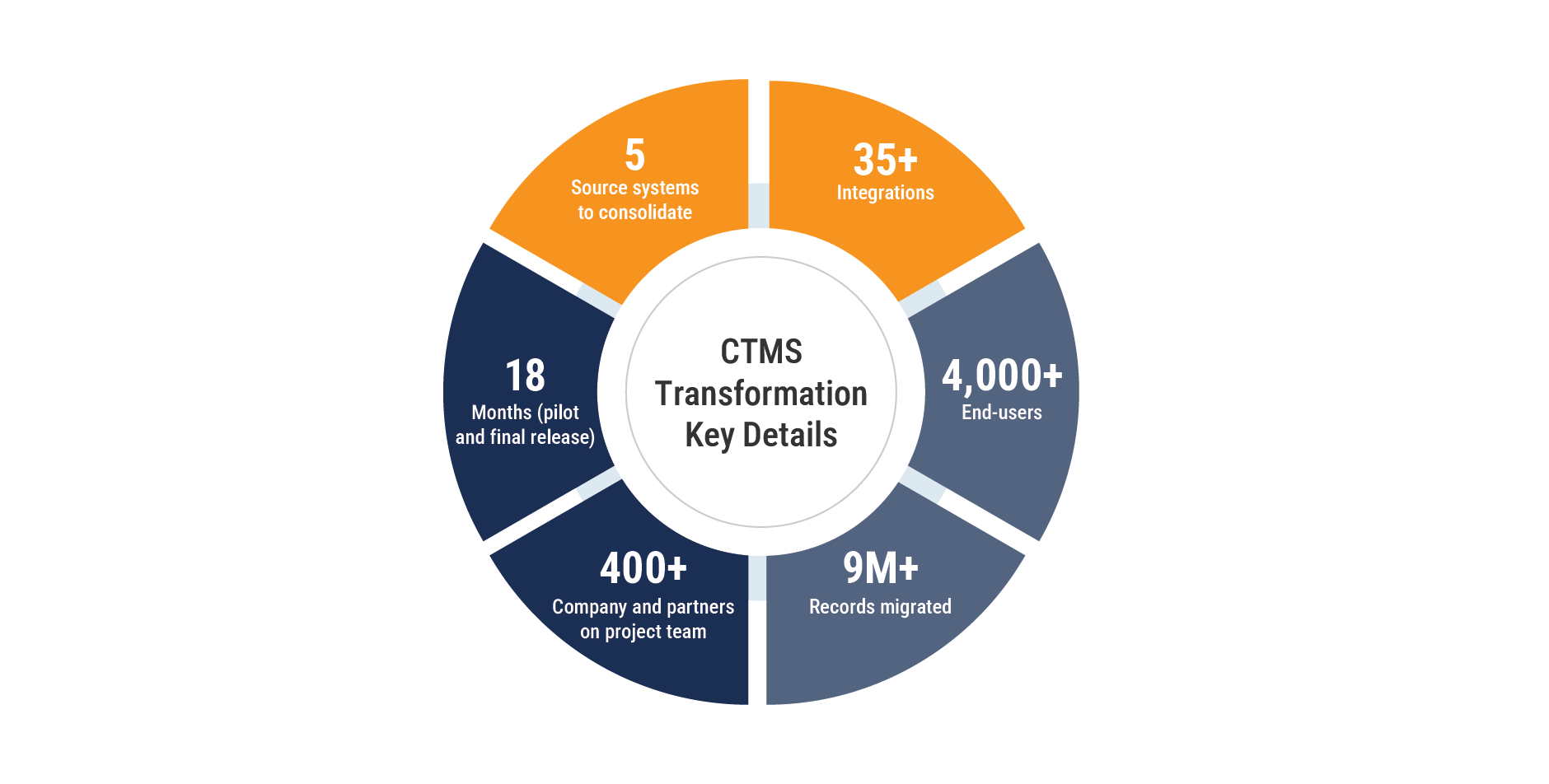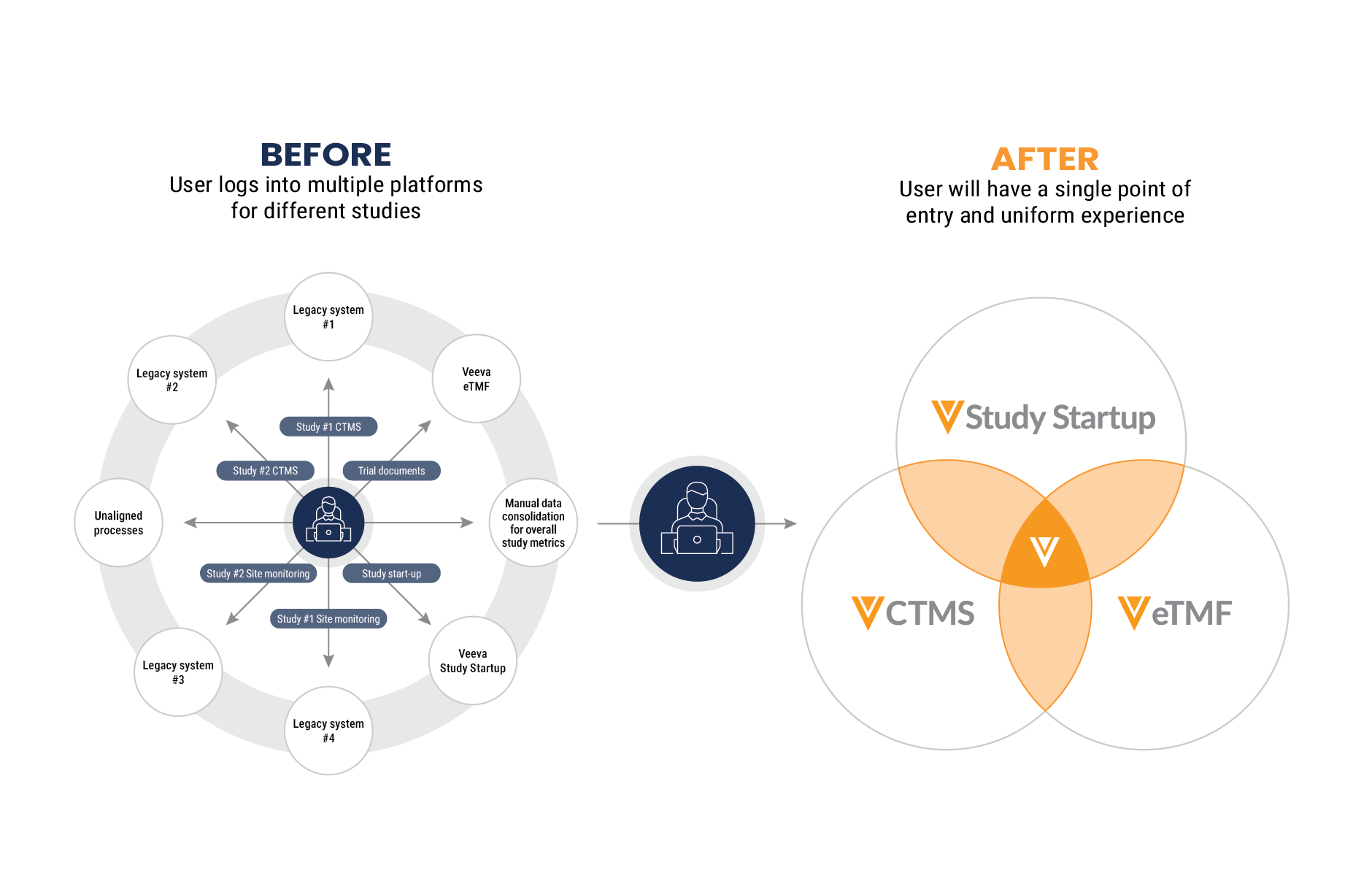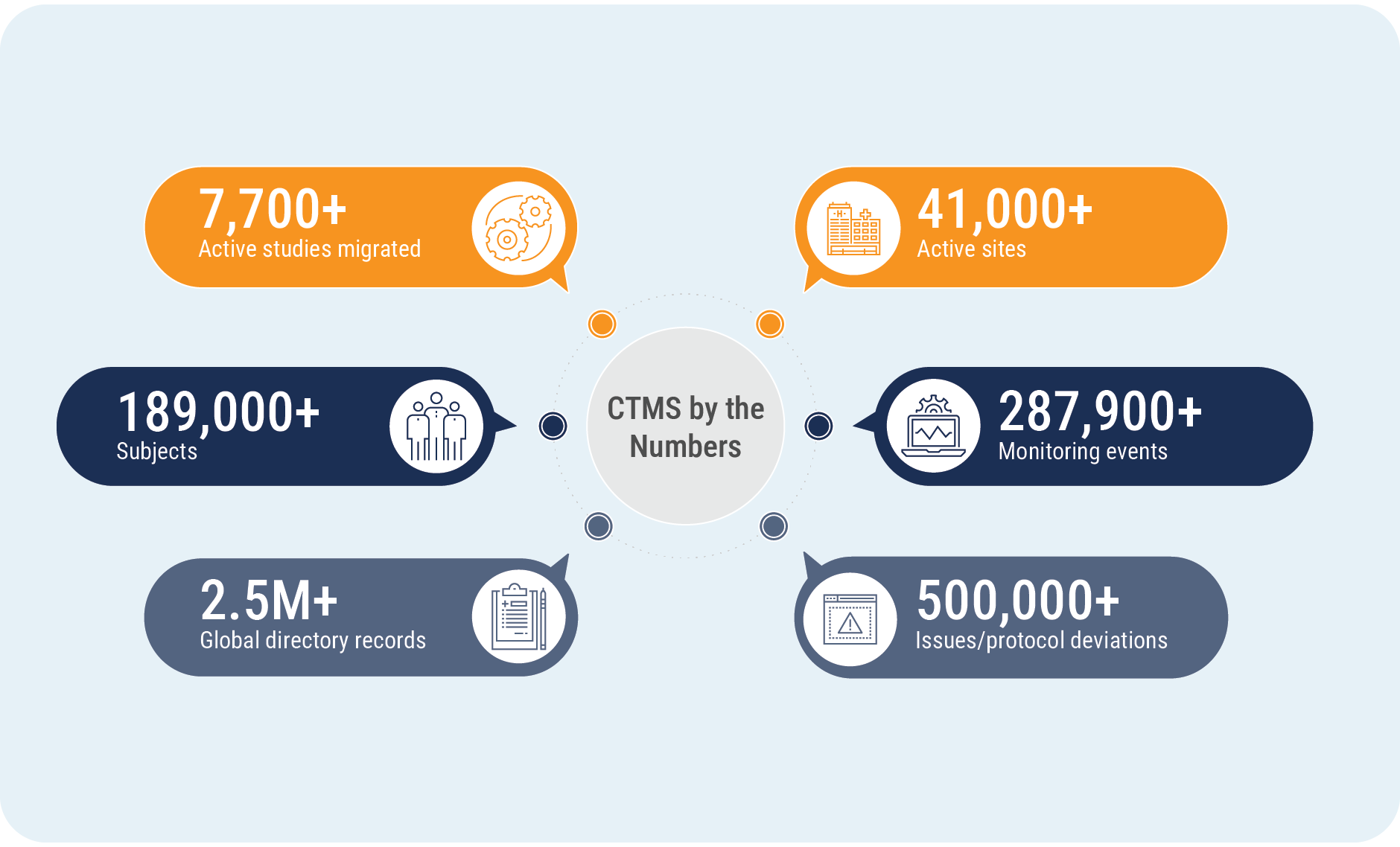How a Top 20 Biopharma Modernized its Legacy CTMS
A clinical trial management system (CTMS) is often referred to as the heart of clinical operations. Changing that system can feel intimidating, especially at a large organization. But, replacing a legacy CTMS can help biopharmas build a strong foundation for innovation.
After a top 20 biopharma completed one of the largest acquisitions in recent life sciences history, the company’s director of Veeva platforms knew his team needed to migrate to a new CTMS. The stakes were high. Not only did his team have to figure out the best way to converge two legacy CTMS applications and two homegrown site monitoring systems, but they also had to manage this massive project during the height of the COVID-19 pandemic when resource turnover was at an all-time high.
In just 18 months, the top 20 biopharma migrated more than nine million records and consolidated data from five systems into Veeva CTMS. The company also trained and onboarded over 4,000 Veeva CTMS users.

Now that his team has come out on the other side, the company’s director of Veeva platforms shares some key learnings from their CTMS modernization journey.
Don’t underestimate the value of a unified platform
Before moving to the Veeva Clinical Platform, the top 20 biopharma had to manage various on-premise, locally hosted systems. Each system was siloed, forcing users to log in to multiple platforms for different studies and manually consolidate data for overall study metrics.
Now, the company has a unified, cloud-based solution that is scalable and reliable. Since implementing Veeva CTMS alongside Veeva eTMF and Veeva Study Startup, the company has fewer systems to manage. That translates to fewer integrations, shorter cycle times, and significant cost savings.

Embrace continuous improvement
Although software implementations can be overwhelming, they also give you the opportunity to reimagine business processes. For example, one of the major changes the top 20 biopharma made since implementing its new CTMS is piggybacking its software update release schedule on top of Veeva’s three upgrades per year.
When Veeva has an upcoming release, the company uses that as an opportunity to address suggested improvements from internal stakeholders. The director of Veeva platforms also conducts impact assessments a few weeks before the planned release date to ensure it goes smoothly. That way, the company can run its entire software development life cycle (SDLC), including business process changes and validation, with the current Veeva release.
“Since embracing a unified clinical platform, we’ve reduced duplicate activities, integrations, and cycle time,” says the top 20 biopharma’s director of Veeva platforms. His next goal is to look at the Veeva Clinical Platform holistically as one product. “Currently, we still have teams solely focused on eTMF, CTMS, and Study Startup. As we look toward the future, we want to eventually have a unified SDLC and release plan for all of these solutions together,” he explains.
Managing data during a software implementation
The most difficult part of implementing a new software system is migrating, integrating, and consolidating dozens of disparate data sources. This top 20 biopharma’s challenges were twofold. First, the company had to connect disparate systems after completing its acquisition. Then, the company needed migrate over nine million records – including over 7,700 active studies, 41,000 active sites, 189,000 patients, 287,900 monitoring events, 2.5 million global directory records, and 500,000 protocol deviations – to the Veeva Clinical Platform.

“My biggest piece of advice for those embarking on a new CTMS implementation is to define the scope of your project as early as possible,” says the top 20 biopharma’s director of Veeva platforms. “Give your cross-functional teams plenty of time to plan for business workarounds and account for the downtime that will likely be necessary to migrate data from your legacy system.”
A couple of months before go-live, the director of Veeva programs worked with stakeholders across his organization to figure out which business processes would be affected by the CTMS migration. Next, he identified which activities could wait until the new CTMS was in place and which ones had to happen during the migration period. Then, he established the necessary manual workarounds to keep those activities going.
Assess your system architecture
Implementing Veeva CTMS gave the top 20 biopharma an opportunity to evaluate its system architecture more holistically. “Since Veeva CTMS is at the heart of our clinical operations tech stack, we chose our integrations with Veeva in mind,” says the company’s director of Veeva platforms.
The top 20 biopharma also implemented an enterprise data lake and created APIs to move data to and from Veeva CTMS to streamline integrations to our upstream and downstream systems. Now, all the data from every system within its software infrastructure flows to one place – including data from legacy systems. When cross-functional teams need certain data for their day-to-day operations, they can easily access it in the data lake.
Prepare for pilot studies
Once the infrastructure is in place, it’s time to pilot your new system. When choosing pilot studies, be sure to choose those that are representative of your trial portfolio, actively recruiting patients, and monitoring sites. This gives you the opportunity to test out as many software capabilities as possible while leaving time for users to give meaningful feedback before go-live. For example, the top 20 biopharma launched four pilot studies with Veeva CTMS for about eight months prior to the official rollout and sunsetting of its previous CTMS.
Focus on feature parity
One of the biggest concerns companies face when migrating from legacy systems is achieving feature parity in new software configurations. The best way to ensure feature parity is to make sure that your feature mappings are accurate and complete. At the top 20 biopharma, the clinical team used their previous system for more than 10 years and it was highly customized to their specific business processes. When it came time to define their fields, the team went through an extensive mapping process to figure out where features from the legacy system would fit into Veeva CTMS.
Prioritizing the configuration also helped the company get to migration faster. Since configuration must be finalized before migration can begin, be sure to lock down your configuration as quickly as possible to give yourself ample time for testing.
Change management best practices
A crucial yet often overlooked aspect of a successful implementation is an effective change management strategy that drives user adoption. Even the best technology and practices won’t change performance if team members don’t adopt and use them effectively. At the top 20 biopharma, the key to driving adoption was proactively communicating changes to give teams time to digest information and ask questions.
Create robust adoption plans
Having a robust communication plan is essential to prepare stakeholders for change. At the top 20 biopharma, the director of Veeva platforms adopted a “train the trainer” approach. He appointed 150 subject matter experts (SMEs) across the organization to lead training sessions for their teams. He also created a dedicated change management group that gathered feedback during the company’s pilot studies and conducted change-impact analyses. When gathering feedback, he used a help-desk system where users submitted tickets that were addressed before go-live.
In addition to SME training, the top 20 biopharma also sent CTMS-specific newsletters to all relevant stakeholders and created a steering committee that kept leadership informed of changes and project timelines.
On the day Veeva CTMS went live, the company already had over 2,500 users trained and ready to use the system. Since then, the company has delivered training to over 1,500 more global end-users. The group of 150 SMEs has also transitioned to a newly established “super user” network that continues to meet with their teams to discuss CTMS updates.
Consider the impact on your CROs
It’s a common misconception that changing a pivotal system like a CTMS can make it difficult to integrate data from your CRO partners – especially if they use different software. “In our case, we did not ask our CROs to change anything about how they provide data to us. Instead, we built the ability to consume the same file structure we previously used directly into Veeva CTMS,” says the director of Veeva programs. “Although we can still work with data from different CTMS applications, we are looking at using other options in the future, such as Veeva’s CTMS Transfer.
Continuously talk to other sponsors
Tap into your network of colleagues at other sponsors to collaborate, share experiences, and learn from each other. “My team continuously talked to our colleagues at another top 20 biopharma who previously implemented Veeva CTMS to help guide us,” says the company’s director of Veeva platforms. “Remember: plenty of sponsors have gone through large-scale organizational transformation. You don’t have to go it alone.”
